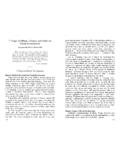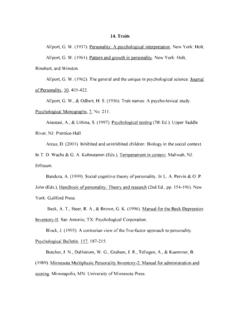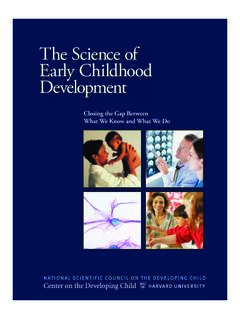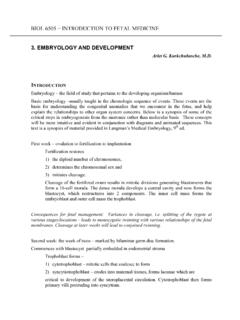Transcription of refs - ch 9 - swppr.org
1 9. Erikson Crain, W. (2005). Theories of development: Concepts and applications (5th Ed.). Upper Saddle River, NJ: Pearson Prentice Hall. de St. Aubin, E., McAdams, D. P., & Kim, (Eds.). (2003). The generative society: Caring for future generations. Washington, DC: American Psychological Association. Economist, The. (2006, July 1-7th). The new powers in giving. The Economist, 380, pp. 63-65. Erikson, E. H. (1985). Childhood and society. New York: W. W. Norton. (Originally published in 1950.) Erikson, E. H. (1958). Young man Luther. New York: W. W. Norton. Erikson, E. H. (1968). Identity: Youth and crisis. New York: W. W. Norton. Erikson, E. H. (1969). Gandhi s truth: On the origins of militant nonviolence.
2 New York: W. W. Norton. Erikson, E. H. (1973). Conversations with Huey P. Newton. In K. T. Erikson (Ed.), In search of common ground. New York: W. W. Norton. Erikson, E. H. (1980). Identity and the life cycle. New York: W. W. Norton. (Originally published in 1959.) Erikson, E. H. (1997). The life cycle completed (extended version). New York: W. W. Norton. (Originally published in 1982.) Friedman, L. J. (1999). Identity s architect: A biography of Erik H. Erikson. New York: Scribner. Gilligan, C. (1982). In a different voice. Cambridge, MA: Harvard University Press. Helsen, R., & Pals, J. (2000). Creative potential, creative achievement, and personal growth. Journal of Personality, 68, 1-27.
3 Kroger, J. (2000). Identity development: Adolescence through adulthood. Thousand Oaks, CA: Sage Press. Kundera, M. (1984). The unbearable lightness of being. New York: Harper & Row. Marcia, J. E. (1966). Development and validation of ego identity status. Journal of Personality and Social Psychology, 3, 551-558. Marcia, J. E. (1980). Identity in adolescence. In J. Adelson (Ed.), Handbook of adolescent psychology (pp. 159-187). New York: Wiley. Masters, W. H., & Johnson, V. E. (1966). Human sexual response. Philadelphia: Lippincott, Williams, & Wilkins. McAdams, D. P. (2001, Jan. 30). Generativity: The new definition of success. Spirituality and Health: The Soul/Body Connection.
4 McAdams, D. P., & de St. Aubin (Eds.). (1998). Generativity and adult development: Caring for the next generation. Washington, DC: American Psychological Association. Miller, A. (1976). Death of a salesman. New York: Penguin. (Originally published in 1949.) Pals, J. (1999). Identity consolidation in early adulthood. Journal of Personality, 67, 295-329. Torenstam, L. (1993). Gerotranscendence: A theoretical and empirical exploration. In L. E. Thomas & S. A. Eisenhandler (Eds.), Aging and the religious dimension. Westport, CN: Greenwood Publishing Group.












